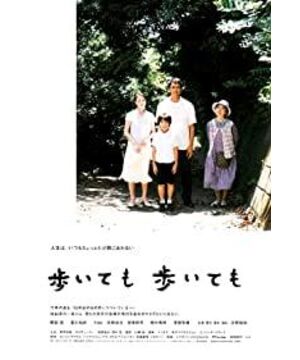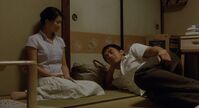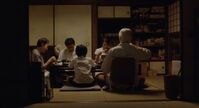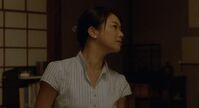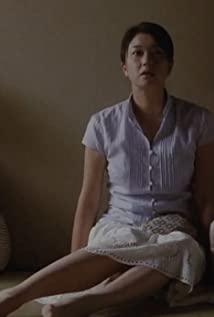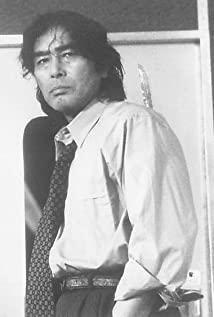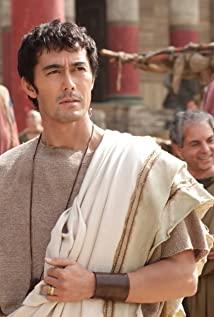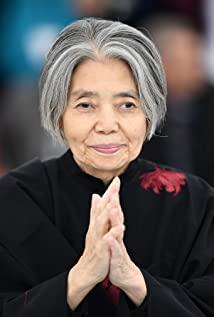"The so-called protagonist refers to the person who dominates the entire movie even if it does not appear on the screen. But what do they do? It is the lines, the emotions, and sometimes the editing. In short, the movie protagonist is the camera. On the side of the director, the breathing rate is synchronized with the person.” (p.133, is Edema Hirokazu)
The film mirrors life in miniature by revolving around the trivial life of the family and worshiping the eldest son within two days. From beginning to end, the eldest son did not appear on the screen as a physical character, but became the core figure connecting the whole plot. "The closer you get, the more you hurt each other." This motif runs through the film, whether it is as small as fried corn tempura or as large as the sea's engulfing of humans, it expresses this main point. The closer you are to fried corn, the easier it is to get oil splashed on your skin; the closer you are to the sea, the higher the risk of being buried in the sea.
Yancheng is the most iconic, seemingly calm, but dramatic, artistic expression of life in the Zhi family. The film conveys the life resonance that no matter what Sun Moon Shun Shuo people can never completely avoid the harm caused by nature and close relationships. People are small in nature. The accidental death of the eldest son is an indelible stormy event for the entire family, especially the original parents, but things will not change with the will of the person, and will not be regained because of human helplessness and anger. The life of the eldest son. Life always needs to continue, and the days have to go forward and keep walking. For example, at 1 hour and 40 minutes in the film, even though the mother urged the family to go to the beach to pay attention to safety, even though the mother was nervous about the safety of the family, the film played calm music at this time. Although the various trivial things that occur with the characters in this day's life are filled with various emotions, the tone of "sorrows still need to be dealt with indifferently" runs through the film, restoring the daily life of the characters from the perspective of pure life. It is not only reflected in the soundtrack, but also in the composition, camera position, setting, scheduling and other levels. This film is still based on a long lens and a fixed lens, and there are many Angelopoulos-style one-point perspective fixed lens passages. At the same time, various other visual processing methods are added. For example, when the old mother sees a butterfly as if the soul is possessed, the video uses a hand-held shaking image to simulate a trance mental state. Therefore, although the overall intention of the film is to shape the real life texture, it does not lose sight of the exploration of illusion, soul, life and death, and memory, creating the chaotic mood and marginal state of the old mother of the characters. It can be seen that the director seems to have made an open artistic sub-topic presentation: on the one hand, there is the implication that a white-haired person sends a black-haired person to be extremely sad; on the other hand, it also expresses the director's doubts about the end of life. Regarding this point, it seems to fit in with "The Next Stop, Heaven", and it is also mixed with literary temperament and philosophical thinking. The tracing of this question is mainly because Hirokazu Ke is not only a documentary-born director, but also a literary graduate who always interprets a literary context in his films. Although on the way of art films, I have been constantly expanding my other dramas: action films, suspense films, love science fiction films and other genres, but the film can always show a consistent personal style: that is, the quality of real life is right. Thinking of life and death. This kind of image style and thought were initially revealed in the debut of "Phantom Light". Under the circumstances of budget and constraints, the filming of "Phantom Light" was completed, and it was Hou Hsiao-hyun who he admired Hou Hsiao-hyun who gave the film to Hou Hsiao-hyun in the first time. After watching it, Hou Xiaoxian suggested that he submit the film to the Venice Film Festival, and was pleasantly surprised by the opportunity to be shortlisted in the main competition unit. The first feature film has already made its mark at the International Film Festival, paving the way for him. But after many years, it was Hirokazu Ke that he was unwilling to admit that "Phantom Light" was his debut work. Not because of the quality of the film, but because many traces of famous directors in film history can be seen from "Phantom Light", not only Hou Xiaoxian, who gave important guidance, Theo Angelopoulos ("Eternal and One Day", The styles of European directors such as "Landscape in the Mist"), Victor Ellis ("Honeycomb Ghost", "Southern") and other European directors are also traceable in "Phantom Light". "It's too much like the graduation thesis of a student who loves movies." It is Hirokazu's own evaluation of "Phantom Light". So after "Phantom Light", it was Hirokazu Edema dedicated to exploring his own style. The next two feature films "Next Stop, Heaven" (1998) and "Distance" (2001) are both experimental films. As "Distance" was influenced by the film movement "Dougma 95", DV and live shooting have become iconic image features of "Distance". In "Distance", the fixed-camera long lens that was highly acclaimed in "Phantom Light" was discarded, and a hand-held lens with a rougher audio-visual style was chosen. "People are more important than stories." This view began to be deeply imprinted in Shiede Hirohe's heart and became his golden rule. When it came to "Non-stop", the director once again returned to the fixed-length lens, forming an image style with a fixed-length lens as the mainstay and a shaking hand-held lens as a supplement. It can be regarded as a big summary of the style of the previous film. "Film and TV are not for self-expression, but for communication." It is Hirokazu Ee who continues to use films to talk to the world about the essence of life.
The original intention of the director to create this film was to mourn his mother with the film, and the mother's pace did not go away from the director's world. Therefore, although the documentary director was born as a documentary filmmaker Hirokazu, although he tried to restore the real life through a series of life fragments and details, he did not stop there, but at the same time included a glimmer of hope. The director does not give a limited conclusion on the phenomenon in reality, but hopes to deal with the emotional chord that touches the audience's heart through the magic and real, leaving room for thinking. Keep walking, always remember the dead relatives; never stop thinking about life.
View more about Still Walking reviews


